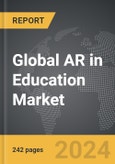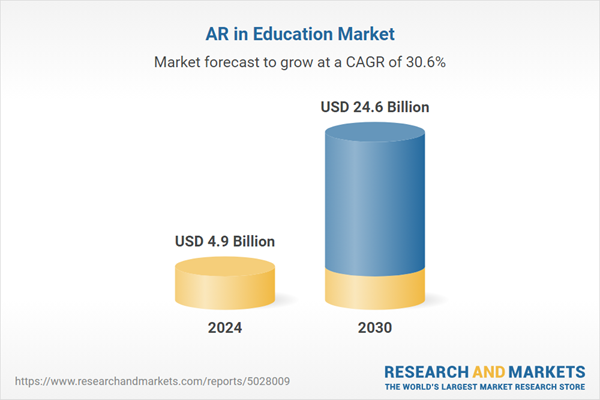The global market for AR in Education was valued at US$4.9 Billion in 2024 and is projected to reach US$24.6 Billion by 2030, growing at a CAGR of 30.6% from 2024 to 2030. This comprehensive report provides an in-depth analysis of market trends, drivers, and forecasts, helping you make informed business decisions. The report includes the most recent global tariff developments and how they impact the AR in Education market.
Segments: End-Use (Higher Education, Primary & Secondary Education, K-12).
Geographic Regions/Countries: World; United States; Canada; Japan; China; Europe (France; Germany; Italy; United Kingdom; and Rest of Europe); Asia-Pacific; Rest of World.
The analysts continuously track trade developments worldwide, drawing insights from leading global economists and over 200 industry and policy institutions, including think tanks, trade organizations, and national economic advisory bodies. This intelligence is integrated into forecasting models to provide timely, data-driven analysis of emerging risks and opportunities.
Global AR in Education Market - Key Trends and Drivers Summarized
How Is AR Revolutionizing Educational Experiences?
Augmented Reality (AR) is rapidly transforming the educational landscape by enhancing traditional learning methods with interactive, immersive experiences that engage students in entirely new ways. Unlike conventional education tools, AR brings abstract concepts to life by overlaying digital content onto the physical world, allowing students to visualize and interact with 3D models, simulations, and other virtual elements. This technology has proven particularly effective in subjects that require spatial understanding, such as anatomy, engineering, and geometry, where students can explore complex structures from multiple angles. AR's ability to merge the digital and physical realms not only makes learning more engaging but also caters to diverse learning styles, offering a hands-on, experiential approach that can be tailored to individual needs. As a result, AR is not just supplementing traditional educational methods but is redefining them, making learning more dynamic, interactive, and accessible to students across different age groups and disciplines.What Technological Advancements Are Driving the Integration of AR in Education?
The integration of AR in education has been significantly accelerated by advancements in both hardware and software technologies. The widespread availability of smartphones and tablets equipped with advanced sensors and high-resolution cameras has made AR more accessible to educators and students alike. Additionally, the development of AR-specific educational platforms and applications, such as Google Expeditions and Merge Cube, has provided teachers with ready-made tools to incorporate AR into their curricula. These platforms offer a range of content, from virtual field trips to interactive science experiments, that can be easily integrated into classroom activities. Furthermore, advancements in AI and machine learning are enhancing the capabilities of AR in education, enabling more personalized learning experiences. AI-driven AR applications can adapt to the individual learning pace of students, providing real-time feedback and adjusting the difficulty level based on student performance. These technological innovations are not only making AR more versatile and effective in educational settings but are also lowering the barriers to adoption, allowing more institutions to incorporate AR into their teaching methods.What Emerging Trends Are Shaping the Future of AR in Education?
Several emerging trends are shaping the future of AR in education, reflecting broader shifts in pedagogical approaches and technological innovation. One of the most significant trends is the growing emphasis on STEM (Science, Technology, Engineering, and Mathematics) education, where AR is being increasingly utilized to create immersive learning experiences that enhance student understanding of complex scientific concepts. Another trend is the integration of AR with gamification, where educational content is presented in a game-like environment, making learning more engaging and motivating for students. This approach is particularly effective in capturing the attention of younger learners who are accustomed to interactive digital environments. Additionally, AR is playing a crucial role in distance and remote learning, providing virtual hands-on experiences that are otherwise difficult to replicate outside of a traditional classroom. This has become especially relevant in the wake of the COVID-19 pandemic, which has accelerated the adoption of digital learning tools. The expansion of AR into lifelong learning and professional training programs is also noteworthy, as it opens up new opportunities for continuous education and skill development beyond formal schooling.What Factors Are Driving Growth in the AR in Education Market?
The growth in the AR in education market is driven by several factors that are closely tied to technological advancements, changing educational paradigms, and evolving consumer expectations. Firstly, the increasing demand for personalized and adaptive learning experiences is pushing schools and educational institutions to adopt AR technologies that can cater to diverse student needs. Secondly, the rising investment in EdTech by governments and private organizations is fueling the development and deployment of AR tools across various educational settings. Thirdly, the shift towards digital and remote learning, accelerated by the global pandemic, has created a strong demand for interactive and immersive learning solutions, with AR emerging as a key enabler. Additionally, the growing focus on improving student engagement and retention rates is encouraging educators to explore innovative teaching methods, with AR being a prominent choice due to its ability to make learning more interactive and enjoyable. Furthermore, the expansion of AR applications into higher education and professional training programs is broadening the market's reach, attracting a wider audience beyond K-12 education. These factors, combined with ongoing technological innovations and a supportive regulatory environment, are driving the robust growth of the AR in education market.Report Scope
The report analyzes the AR in Education market, presented in terms of units. The analysis covers the key segments and geographic regions outlined below.Segments: End-Use (Higher Education, Primary & Secondary Education, K-12).
Geographic Regions/Countries: World; United States; Canada; Japan; China; Europe (France; Germany; Italy; United Kingdom; and Rest of Europe); Asia-Pacific; Rest of World.
Key Insights:
- Market Growth: Understand the significant growth trajectory of the Higher Education End-Use segment, which is expected to reach US$14.7 Billion by 2030 with a CAGR of a 32.5%. The Primary & Secondary Education End-Use segment is also set to grow at 29.9% CAGR over the analysis period.
- Regional Analysis: Gain insights into the U.S. market, valued at $1.3 Billion in 2024, and China, forecasted to grow at an impressive 28.9% CAGR to reach $3.6 Billion by 2030. Discover growth trends in other key regions, including Japan, Canada, Germany, and the Asia-Pacific.
Why You Should Buy This Report:
- Detailed Market Analysis: Access a thorough analysis of the Global AR in Education Market, covering all major geographic regions and market segments.
- Competitive Insights: Get an overview of the competitive landscape, including the market presence of major players across different geographies.
- Future Trends and Drivers: Understand the key trends and drivers shaping the future of the Global AR in Education Market.
- Actionable Insights: Benefit from actionable insights that can help you identify new revenue opportunities and make strategic business decisions.
Key Questions Answered:
- How is the Global AR in Education Market expected to evolve by 2030?
- What are the main drivers and restraints affecting the market?
- Which market segments will grow the most over the forecast period?
- How will market shares for different regions and segments change by 2030?
- Who are the leading players in the market, and what are their prospects?
Report Features:
- Comprehensive Market Data: Independent analysis of annual sales and market forecasts in US$ Million from 2024 to 2030.
- In-Depth Regional Analysis: Detailed insights into key markets, including the U.S., China, Japan, Canada, Europe, Asia-Pacific, Latin America, Middle East, and Africa.
- Company Profiles: Coverage of players such as Aug That, Blippar, Chromville, Curiscope Ltd., DAQRI and more.
- Complimentary Updates: Receive free report updates for one year to keep you informed of the latest market developments.
Some of the 137 companies featured in this AR in Education market report include:
- Aug That
- Blippar
- Chromville
- Curiscope Ltd.
- DAQRI
- EON Reality, Inc.
- GAMOOZ Interactive Solutions Pvt. Ltd.
- Google LLC
- InGage Technologies
- Magic Leap, Inc.
- Meta Company
- Popar
- QuiverVision Limited
Tariff Impact Analysis: Key Insights for 2025
Global tariff negotiations across 180+ countries are reshaping supply chains, costs, and competitiveness. This report reflects the latest developments as of April 2025 and incorporates forward-looking insights into the market outlook.The analysts continuously track trade developments worldwide, drawing insights from leading global economists and over 200 industry and policy institutions, including think tanks, trade organizations, and national economic advisory bodies. This intelligence is integrated into forecasting models to provide timely, data-driven analysis of emerging risks and opportunities.
What’s Included in This Edition:
- Tariff-adjusted market forecasts by region and segment
- Analysis of cost and supply chain implications by sourcing and trade exposure
- Strategic insights into geographic shifts
Buyers receive a free July 2025 update with:
- Finalized tariff impacts and new trade agreement effects
- Updated projections reflecting global sourcing and cost shifts
- Expanded country-specific coverage across the industry
Table of Contents
I. METHODOLOGYII. EXECUTIVE SUMMARY2. FOCUS ON SELECT PLAYERSIII. MARKET ANALYSISIV. COMPETITION
1. MARKET OVERVIEW
3. MARKET TRENDS & DRIVERS
4. GLOBAL MARKET PERSPECTIVE
UNITED STATES
CANADA
JAPAN
CHINA
EUROPE
FRANCE
GERMANY
ITALY
UNITED KINGDOM
REST OF EUROPE
ASIA-PACIFIC
REST OF WORLD
Companies Mentioned (Partial List)
A selection of companies mentioned in this report includes, but is not limited to:
- Aug That
- Blippar
- Chromville
- Curiscope Ltd.
- DAQRI
- EON Reality, Inc.
- GAMOOZ Interactive Solutions Pvt. Ltd.
- Google LLC
- InGage Technologies
- Magic Leap, Inc.
- Meta Company
- Popar
- QuiverVision Limited
Table Information
| Report Attribute | Details |
|---|---|
| No. of Pages | 242 |
| Published | April 2025 |
| Forecast Period | 2024 - 2030 |
| Estimated Market Value ( USD | $ 4.9 Billion |
| Forecasted Market Value ( USD | $ 24.6 Billion |
| Compound Annual Growth Rate | 30.6% |
| Regions Covered | Global |









